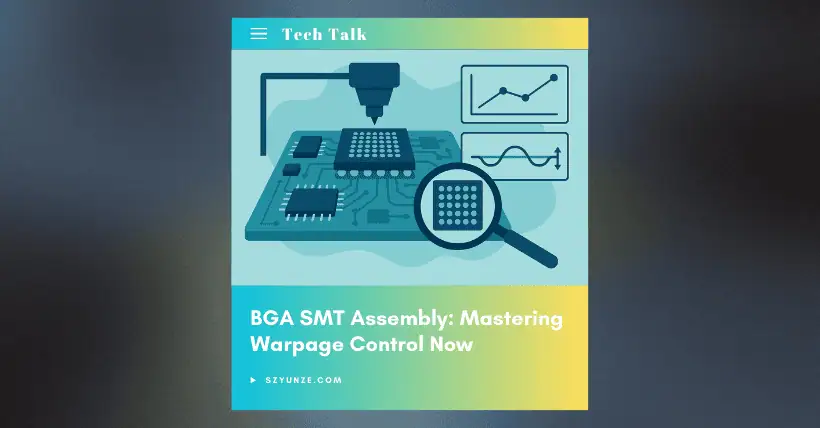In the BGA (Ball Grid Array) assembly process, warpage control is a key factor in ensuring solder joint reliability and yield. Warpage can lead to defects such as solder joint stress concentration, Head-in-Pillow (HiP) effect, cold solder joints, and even substrate cracking. Based on IPC standards and equipment technical specifications, the core technologies for preventing warpage are summarized into the following four categories:
01
Design Preventive Control
Substrate Material Optimization
Use laminate materials with a high glass transition temperature (Tg) (such as FR-5 or high-frequency materials) to reduce thermal deformation during high-temperature reflow soldering. Ensure symmetrical PCB stack-up design (balanced copper distribution and dielectric thickness) to avoid warpage caused by mismatched coefficients of thermal expansion (CTE).
Pad and Solder Mask Design
Prioritize the use of Non-Solder Mask Defined (NSMD) pads to prevent the solder mask from covering pad edges and reduce solder joint stress. Optimize pad size and spacing (refer to IPC-7351 standards), for example, pad diameter ≤ 80% of solder ball diameter, to reduce the risk of uneven collapse.
02
Process Control Technology
Dynamic Support System
Use automatic support pin devices (such as placement head or integrated track systems) to dynamically adjust support positions based on board bending profiles, ensuring even mounting pressure.
Soft Support Pins
Use soft pins (e.g., silicone material) to cushion placement impact and reduce localized stress concentration.
Adaptive Mounting Height Adjustment
Real-time scanning of PCB warpage by board height detection units allows automatic Z-axis height compensation, ensuring consistent solder paste collapse volume.
Refined Reflow Profile Optimization
Optimize the reflow temperature profile (e.g., extend preheating time, lower peak temperature) to reduce thermal stress caused by CTE differences. In lead-free processes, stricter control of ramp rate is required (recommended 1–2°C/s) to avoid sudden thermal deformation due to vapor phase soldering.
03
Online Monitoring and Feedback
Real-Time Strain Testing
Attach strain gauges near key components to monitor micro-strain during assembly, depaneling, and rework (IPC-9704A suggests a limit of <500με). Correct processes exceeding thresholds (e.g., adjust depaneling tool paths or add support).
3D Coplanarity Inspection
Use laser profilometers or optical scanning systems to check coplanarity of BGA solder balls and PCB pads before placement (standard requirement: ≤0.1 mm).
04
Defect Prevention and Rework Standards
Depaneling Process Optimization
Avoid stress concentration at edges caused by V-cut depaneling; instead, use milling or laser cutting, and implement strain monitoring.
Rework Process Standardization
Use a bottom preheating platform (≥150°C) during BGA rework to reduce secondary warpage caused by local temperature differences. Post-rework inspections must include X-ray (to check for HiP) and mechanical shock testing (e.g., IPC-9704 vibration testing).
05
Key Control Point Summary
| Control Stage | Core Technology |
|---|---|
| Design Prevention | High Tg Materials + Symmetrical Stack-up |
| Process | Dynamic Support + Adaptive Mounting Height |
| Online Monitoring | Strain Gauge Testing + 3D Coplanarity Scanning |
| Rework & Depaneling | Bottom Preheating + Strain Control During Depaneling |
Note: Warpage control must span the entire product lifecycle. In the design phase, use simulation tools to predict deformation (e.g., Mentor Xpedition), and in the production phase, rely on real-time data feedback loops (e.g., LCR inspection units) to ensure long-term BGA reliability under thermal cycling and mechanical load.

Disclaimer:
- This channel does not make any representations or warranties regarding the availability, accuracy, timeliness, effectiveness, or completeness of any information posted. It hereby disclaims any liability or consequences arising from the use of the information.
- This channel is non-commercial and non-profit. The re-posted content does not signify endorsement of its views or responsibility for its authenticity. It does not intend to constitute any other guidance. This channel is not liable for any inaccuracies or errors in the re-posted or published information, directly or indirectly.
- Some data, materials, text, images, etc., used in this channel are sourced from the internet, and all reposts are duly credited to their sources. If you discover any work that infringes on your intellectual property rights or personal legal interests, please contact us, and we will promptly modify or remove it.



